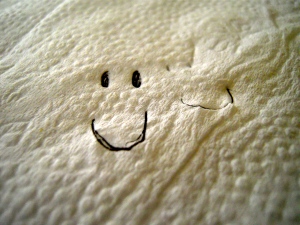*July 3, 2011
I sit on a bed, observing the satellite clinic. A paramedic, donning a worn white coat, sits at one of the longer sides of a rectangular table. One edge of the table is filled with medicine – various small tablets, pills, packages and boxes. The patient records, notebooks, lie in front of her. To her direct right, there is a chair for the community members to sit and tell her their grievances. Listening, she measures their blood pressure or temperature, or talks to them, and prescribes medicine.
The FCMs surround the table. One sits directly behind the patient, helping voice her precise health condition. The house itself is one of the FCMs’. I can’t help but notice an empty white bag, not far from where I am, hung on a bamboo support for the dwelling. “World Food Programme” is printed on its side with huge blue letters, followed by a picture of the Japanese flag. The family had received a ration of rice, as a “gift from the people of Japan.” What a striking situation, to get to see the receiving side.
This is my second day observing the chars and first day of official data collection on this island called Shirajbeg. Sareeta Apa and I will conduct interviews with the FCM, the paramedic, and the paramedic assistant on this char. We’ll also hold a focus group discussion with community members who attend the health meeting, lead and given by the FCM.
Shirajbeg is one of the closer chars to the mainland. It took us about half an hour to get here by boat.
Yesterday, we visited Bozradiarkhata, where we tested some of our survey tools before starting to collect data. It was also on this char that I paid a visit to one of Friendship’s vocational training centers, where women learn how to weave and earn a living doing so, creating beautiful cloth.
Shirajbeg is younger than Bozradiarkhata. It’s sandier and the vegetation is shorter across the island.
The house we’re in has all the components of what you would envision would come with a makeshift settlement: hard-pressed dirt floors, a thatched roof and sides of reeds. The hut is small, and it’s clearly leaky during monsoon. Sides of the house are wet from the rain, with buckets strewn about to catch drips of water.
There is a growing line of waiting patients circling the house, all women, facing the heat to visit the satellite clinic (which costs 5 taka, or less than 0.07 cents). The scene is incredibly colorful. Each woman wears bright, catching colors in their saris. (I’ll really miss this about Bangladesh.) I also notice that all of the women come with at least one baby, which they casually carry at the hip. The babies are mostly undressed, except for a rope that they wear at the belly to ward off evil or malign influences. One by one, they sit in front of the paramedic, some to talk about contraception and others to get medicine for their babies. I can tell some of the children have watery eyes from fever, but almost all of the kids around me are incredibly underweight. They seem delicate; I’ve never seen bone on bone like this before.
I have also never been in a place where I am so constantly aware of different components of my identity – white, Turkish, woman, unmarried, Muslim. I have limited communication with the char communities, but they ascertain my status on some of these things pretty well nevertheless. And I’m proud to say I have mastered several key Bangla phrases, so why not use them as much as I can, no matter how ridiculous I may sound? In addition to the Bangla, I communicate in other ways, like yesterday, when a pre-teen girl and I winked back and forth for about three hours. Later today, I met the young daughter of a doctor on EFH. I drew for her a smile on a napkin, and she returned the gesture. What can I say? Like many overly naïve and idealistic travelers have uttered before me, the language of winks and smiles proves universal.






Great pictures, Burcu. I’m also glad to see you are finding innovative ways to communicate with the people 🙂 I hope your data collection is going smoothly.Stay healthy!
Thanks, Bindhu! I hope you’re having a wonderful time, as well. When do you go back to Chapel Hill?